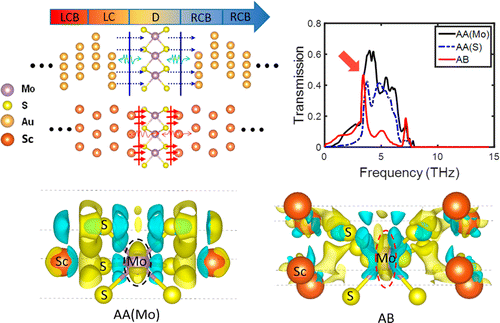当前位置:
X-MOL 学术
›
ACS Appl. Mater. Interfaces
›
论文详情
Our official English website, www.x-mol.net, welcomes your
feedback! (Note: you will need to create a separate account there.)
The Role of Interfacial Electronic Properties on Phonon Transport in Two-Dimensional MoS2 on Metal Substrates
ACS Applied Materials & Interfaces ( IF 8.3 ) Pub Date : 2016-11-22 00:00:00 , DOI: 10.1021/acsami.6b10608
Zhequan Yan 1 , Liang Chen 2 , Mina Yoon 3 , Satish Kumar 1
ACS Applied Materials & Interfaces ( IF 8.3 ) Pub Date : 2016-11-22 00:00:00 , DOI: 10.1021/acsami.6b10608
Zhequan Yan 1 , Liang Chen 2 , Mina Yoon 3 , Satish Kumar 1
Affiliation

|
We investigate the role of interfacial electronic properties on the phonon transport in two-dimensional MoS2 adsorbed on metal substrates (Au and Sc) using first-principles density functional theory and the atomistic Green’s function method. Our study reveals that the different degree of orbital hybridization and electronic charge distribution between MoS2 and metal substrates play a significant role in determining the overall phonon–phonon coupling and phonon transmission. The charge transfer caused by the adsorption of MoS2 on Sc substrate can significantly weaken the Mo–S bond strength and change the phonon properties of MoS2, which result in a significant change in thermal boundary conductance (TBC) from one lattice-stacking configuration to another for same metallic substrate. In a lattice-stacking configuration of MoS2/Sc, weakening of the Mo–S bond strength due to charge redistribution results in decrease in the force constant between Mo and S atoms and substantial redistribution of phonon density of states to low-frequency region which affects overall phonon transmission leading to 60% decrease in TBC compared to another configuration of MoS2/Sc. Strong chemical coupling between MoS2 and the Sc substrate leads to a significantly (∼19 times) higher TBC than that of the weakly bound MoS2/Au system. Our findings demonstrate the inherent connection among the interfacial electronic structure, the phonon distribution, and TBC, which helps us understand the mechanism of phonon transport at the MoS2/metal interfaces. The results provide insights for the future design of MoS2-based electronics and a way of enhancing heat dissipation at the interfaces of MoS2-based nanoelectronic devices.
中文翻译:

界面电子性质在金属基底上二维MoS 2中声子输运中的作用
我们使用第一原理密度泛函理论和原子格林函数方法研究了界面电子性质在金属基底(Au和Sc)上吸附的二维MoS 2中声子传输中的作用。我们的研究表明,MoS 2和金属基质之间不同程度的轨道杂化和电子电荷分布在决定整体声子-声子耦合和声子传输中起着重要作用。MoS 2在Sc衬底上的吸附引起的电荷转移会显着削弱Mo–S的键合强度并改变MoS 2的声子性质,这会导致同一金属基板的热边界电导(TBC)从一种晶格堆叠配置到另一种晶格堆叠配置发生显着变化。在MoS 2 / Sc的晶格堆叠构型中,由于电荷的重新分布而使Mo–S键强度减弱,会导致Mo和S原子之间的力常数减小,并且声子密度会大量地重新分布到低频区域,从而与MoS 2 / Sc的另一种配置相比,会影响整体声子的传输,从而导致TBC降低60%。MoS 2和Sc底物之间的强化学偶联导致的TBC比弱结合的MoS 2的TBC显着高(〜19倍)/ Au系统。我们的发现证明了界面电子结构,声子分布和TBC之间的内在联系,这有助于我们了解MoS 2 /金属界面处声子传输的机理。结果为未来基于MoS 2的电子产品的设计提供了见识,并为增强基于MoS 2的纳米电子设备的界面处的散热提供了一种方法。
更新日期:2016-11-22
中文翻译:

界面电子性质在金属基底上二维MoS 2中声子输运中的作用
我们使用第一原理密度泛函理论和原子格林函数方法研究了界面电子性质在金属基底(Au和Sc)上吸附的二维MoS 2中声子传输中的作用。我们的研究表明,MoS 2和金属基质之间不同程度的轨道杂化和电子电荷分布在决定整体声子-声子耦合和声子传输中起着重要作用。MoS 2在Sc衬底上的吸附引起的电荷转移会显着削弱Mo–S的键合强度并改变MoS 2的声子性质,这会导致同一金属基板的热边界电导(TBC)从一种晶格堆叠配置到另一种晶格堆叠配置发生显着变化。在MoS 2 / Sc的晶格堆叠构型中,由于电荷的重新分布而使Mo–S键强度减弱,会导致Mo和S原子之间的力常数减小,并且声子密度会大量地重新分布到低频区域,从而与MoS 2 / Sc的另一种配置相比,会影响整体声子的传输,从而导致TBC降低60%。MoS 2和Sc底物之间的强化学偶联导致的TBC比弱结合的MoS 2的TBC显着高(〜19倍)/ Au系统。我们的发现证明了界面电子结构,声子分布和TBC之间的内在联系,这有助于我们了解MoS 2 /金属界面处声子传输的机理。结果为未来基于MoS 2的电子产品的设计提供了见识,并为增强基于MoS 2的纳米电子设备的界面处的散热提供了一种方法。































 京公网安备 11010802027423号
京公网安备 11010802027423号